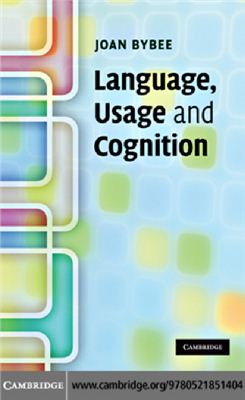Publisher: Cambridge University Press.
Date : 2010.
Pages : 262.
Format : PDF.
Language demonstrates structure while also showing considerable variation at all levels: languages differ from one another while still being shaped by the same principles; utterances within a language differ from one another while exhibiting the same structural pattes; languages change over time, but in fairly regular ways. This book focuses on the dynamic processes that create languages and give them their structure and variance. It outlines a theory of language that addresses the nature of grammar, taking into account its variance and gradience, and seeks explanation in terms of the recurrent processes that operate in language use. The evidence is based on the study of large corpora of spoken and written language, what we know about how languages change, as well as the results of experiments with language users. The result is an integrated theory of language use and language change which has implications for cognitive processing and language evolution.
Language, Usage and Cognition.
Language demonstrates structure while at the same time showing considerable variation at all levels: languages differ from one another while still being shaped by the same principles; utterances within a language differ from one another while still exhibiting the same structural pattes; languages change over time, but in fairly regular ways. This book focuses on the dynamic processes that create languages and give them their structure and their variance.
Joan Bybee outlines a theory of language that directly addresses the nature of grammar, taking into account its variance and gradience, and seeks explanation in terms of the recurrent processes that operate in language use. The evidence is based on the study of large corpora of spoken and written language, and what we know about how languages change, as well as the results of experiments with language users. The result is an integrated theory of language use and language change which has implications for cognitive processing and language evolution.
joan bybee is Distinguished Professor Emerita in the Department of Linguistics at the University of New Mexico. Her previous publications include Phonology and Language Use (Cambridge, 2001) and Frequency of Use and the Organization of Language (2007).
Contents.
1 A usage-based perspective on language.
2 Rich memory for language: exemplar representation.
3 Chunking and degrees of autonomy.
4 Analogy and similarity.
5 Categorization and the distribution of constructions in corpora.
6 Where do constructions come from? Synchrony and diachrony in a usage-based theory.
7 Reanalysis or the gradual creation of new categories? The English Auxiliary.
8 Gradient constituency and gradual reanalysis.
9 Conventionalization and the local vs. the general: Mode English can.
10 Exemplars and grammatical meaning: the specific and the general.
11 Language as a complex adaptive system: the interaction of cognition, culture and use.
Date : 2010.
Pages : 262.
Format : PDF.
Language demonstrates structure while also showing considerable variation at all levels: languages differ from one another while still being shaped by the same principles; utterances within a language differ from one another while exhibiting the same structural pattes; languages change over time, but in fairly regular ways. This book focuses on the dynamic processes that create languages and give them their structure and variance. It outlines a theory of language that addresses the nature of grammar, taking into account its variance and gradience, and seeks explanation in terms of the recurrent processes that operate in language use. The evidence is based on the study of large corpora of spoken and written language, what we know about how languages change, as well as the results of experiments with language users. The result is an integrated theory of language use and language change which has implications for cognitive processing and language evolution.
Language, Usage and Cognition.
Language demonstrates structure while at the same time showing considerable variation at all levels: languages differ from one another while still being shaped by the same principles; utterances within a language differ from one another while still exhibiting the same structural pattes; languages change over time, but in fairly regular ways. This book focuses on the dynamic processes that create languages and give them their structure and their variance.
Joan Bybee outlines a theory of language that directly addresses the nature of grammar, taking into account its variance and gradience, and seeks explanation in terms of the recurrent processes that operate in language use. The evidence is based on the study of large corpora of spoken and written language, and what we know about how languages change, as well as the results of experiments with language users. The result is an integrated theory of language use and language change which has implications for cognitive processing and language evolution.
joan bybee is Distinguished Professor Emerita in the Department of Linguistics at the University of New Mexico. Her previous publications include Phonology and Language Use (Cambridge, 2001) and Frequency of Use and the Organization of Language (2007).
Contents.
1 A usage-based perspective on language.
2 Rich memory for language: exemplar representation.
3 Chunking and degrees of autonomy.
4 Analogy and similarity.
5 Categorization and the distribution of constructions in corpora.
6 Where do constructions come from? Synchrony and diachrony in a usage-based theory.
7 Reanalysis or the gradual creation of new categories? The English Auxiliary.
8 Gradient constituency and gradual reanalysis.
9 Conventionalization and the local vs. the general: Mode English can.
10 Exemplars and grammatical meaning: the specific and the general.
11 Language as a complex adaptive system: the interaction of cognition, culture and use.

